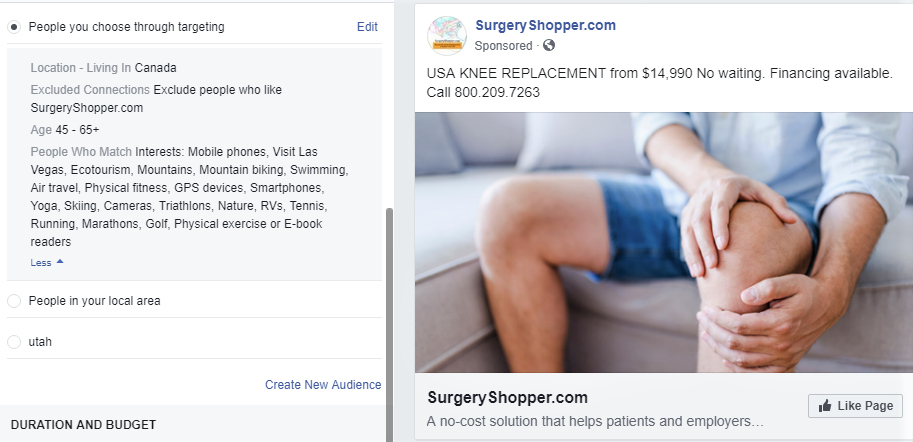Are you one of the thousands who compete for medical tourism and medical travel brand awareness posting promotional advertisements on Facebook expecting unrealistic results. If yes, this article is for YOU!
- So many dollars, hopes, dreams, and effort are invested into Facebook and social media marketing by medical tourism and medical travel startups. On the other hand, a seasoned and experienced health tourism marketing expert requires only milliseconds to review and determine if the marketing strategy is likely to produce results or just add overhead cost and consume capital without Return on Marketing Investment (ROMI).
The ad above is one that I designed and published for SurgeryShopper.com, an American cost containment brand that is keen to attract Canadian patients to the USA and to its pre-inspected and approved surgery facilities, primarily hospitals and ambulatory surgery centers (ASCs).
Prior to publishing this ad, a significant investment in market research was made to determine if advertising to the Canadian market was even feasible.
The Marketing Research
Paid Facebook advertising was conducted on an A/B test with two ads that were quite similar, one that led the target to the home page and another that led visitors to a deep-link “gateway” page for all the surgical procedures on offer (https://surgeryshopper.com/shop-for-surgery/)
The parameters set for targeting were as follows:
- Age: 25-64
- Gender: All
- Location: All USA, certain provinces in Canada, (excluding Quebec and Ontario, specifically) with a target intention of the less urban hinterlands of Canada where elective surgery rapid access is a challenge.
The test ran 10 days. The purpose of the test was threefold:
- to see if anybody clicked on the ad;
- to learn where they were located; and
- to see what visitors did when they arrived on the two landing pages.
Preliminary Research Outcomes
The outcome was interesting. In the research, the results indicated high interest and click through from Canada, Texas, California, Alabama and Ohio.
Among People, overall, the reach was 45.5% women and 54.6% men.
- In the 25-34 age range, the distribution was 5% women and 15% men;
- In the 35-44 age range, the distribution was 7% women and 13% men;
- In the 45-54 age range, the distribution was 8% women and 8% men; and
- In the 55-64 age range, the distribution was 25% women and 18% men.
Well, that blew the standard thinking that women are the primary purchasers and decision-makers of family healthcare matters in North American culture. Next?
Among Devices the consumption of the promotion were as follows:
- News Feed on Mobile Devices was 98%;
- Facebook stories on Mobile Devices 0.8%;
- Instagram Stories on Mobile Devices 0.6%;
- News Feed on Desktop Computers 0.4%; and
- Instagram Feed on Desktop Computers 0.2%
Among Locations, in the A advertisement, the results were as follows:
- Texas 7.2%
- British Columbia 4.9%
- Manitoba 4.6%
- New Brunswick 4.6%
- Nova Scotia 4.5%
- Alberta 4.3%
- California 3.6%
- Saskatchewan 3.4%
- Ohio 3.4%
- Tennessee 3.3%
- Manitoba 12.0%
- New Brunswick 11.5%
- Nova Scotia 10%
- Saskatchewan 7.4%
- Alberta 6.4%
- Texas 5.1%
- Alabama 3.2%
- Kentucky 3.0%
- North Carolina 2.6%
- Ohio 2.6%
- Knee surgery prices (solid margin, high need)
- Hip surgery prices (solid margin, high need)
- Spine surgery prices (solid margin, high need)
- Eye surgery prices (solid margin, high need)
- Hernia surgery prices (low margin, very high need)
Conclusion

About Maria Todd
Maria Todd shares insights from decades of success and experience in medical and dental tourism and health and wellness travel business development and operations. She consults privately to hospitals, surgeons, and ambulatory surgery centers on marketing and branding strategy, tactics, and helps them attract new patients seeking surgery, second opinions, and options other than those where they normally reside. In 2016, she earned certification from Google in digital marketing to help her clients even more. She blogs frequently and generously shares insights she’s learned along the way from doing healthcare marketing, branding, and business development projects in the USA and abroad. She is also the author of 19 healthcare industry best selling professional books, most are available on Amazon.com in both print and e-book formats. Maria is happy to consult in person and remotely to meet your coaching and business development needs. You can purchase time in 15-minute increments if that’s all you believe you’ll need.
